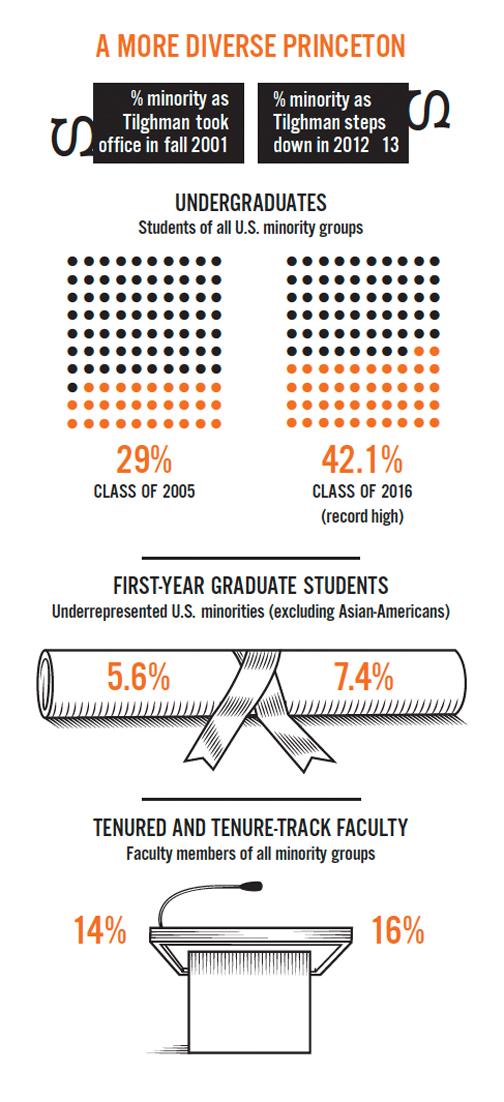Earlier this year, department heads from around the University gathered to watch a video of a faculty search committee discussing the merits of a job applicant. Debate became heated over a female candidate — should she be penalized for having a two-year period with no publications on her résumé, or was that forgivable because she likely had been on maternity leave?
The faculty members in the video were actors, part of a presentation by the Cornell Interactive Theatre Ensemble that explores unconscious biases. The program — presented four times this year to Princeton faculty members — is one of several efforts the University has undertaken to help increase faculty diversity. But despite these initiatives, the makeup of the faculty has not changed much since Tilghman took over the presidency. That stands in contrast to the student body, where 42 percent of members of the Class of 2016 are nonwhite or multiracial — the most diverse class in Princeton’s history.
Tilghman’s efforts to diversify the student body has had critics, and in 2006, an Asian-American student turned down by Princeton filed a federal civil-rights complaint, accusing the University of holding Asian-American applicants to a higher standard in admissions. The case now is part of a broader investigation of Princeton’s handling of Asian-American candidates being conducted by the Department of Education.
In a PAW president’s page this spring, Tilghman celebrated the transformation of the student body before adding, “Unfortunately, progress has been much slower among graduate students, postdoctoral fellows, faculty, and administrators, due in large part to the decentralized nature of their recruitment.” She cited these 2012 statistics: Three percent of doctoral candidates were African American; 20 percent of full professors were female; and 2 percent of senior staff were Hispanic. Her conclusion: “Despite our best efforts, Princeton does not come close to looking like America today.”
There has been some progress in the junior ranks. In 2012, 37 percent of assistant professors were women, compared to 31 percent in 2001. But the number of minority faculty members remains stubbornly low.
Eight years before she took over the presidency, Tilghman lamented the effect of the tenure clock on women, famously labeling tenure “no friend to women” in a New York Times opinion piece. In 2005, Princeton became the first university in the country to grant an automatic one-year extension to the tenure clock for male and female faculty who have a child.
Tilghman has focused on other areas of diversity as well. She drew attention early in her tenure for saying that Princeton needed more “students with green hair,” explaining in a PAW interview after five years in the job that she was referring to students who did not fit the Princeton stereotype and “weren’t the obvious Princeton candidates.” Faculty members told her that they were indeed seeing “a greater breadth of intellectual interests than what they were seeing in the past.” She has been a strong supporter of LGBT students and alumni; during her tenure, Princeton opened the LGBT Center and recently held its first alumni conference for LGBT graduates, partners, and family members.
Just a few months before stepping down, Tilghman signaled an interest in broadening the student body in another direction — by drawing more low-income students. She created a committee, which she has led, to examine ways to help those students overcome obstacles that keep them from attending selective colleges.


